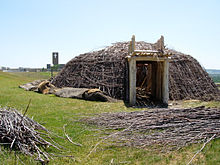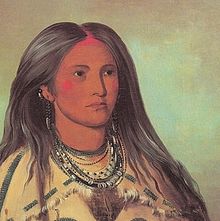Mandan (people)
The Mandan (to German antiquated also: Mandan ; self-description: Numahkahke ) are a small, originally semi-nomadic Indian people of North America from the Sioux language family , which around 1800 at Missouri and at its two tributaries Heart and Knife River lived. Archaeological finds suggest that the Mandan came from the Ohio River valley before moving to the banks of the Missouri. In 1838, a large part of the smallpox epidemic fell victim. As part of the Indian Reorganization Actin 1934, the Mandan officially allied with the Arikara and Hidatsa , forming the Three Affiliated Tribes (" Three Affiliated Tribes "). Half of all descendants of these three tribes now live together in the Fort Berthold Reservation in North Dakota , while the remainder are scattered across the United States and Canada. Some older Mandan still speak the traditional tribal language.
Culture
In contrast to other Plains tribes, the Mandan lived in permanently inhabited villages instead of the semi-nomadic way of life of their neighbors on the Great Plains. In the 19th century, the Mandan lived in dome-shaped, earth-covered huts that were built in palisade-reinforced villages. They planted corn, beans, pumpkin and sunflowers, hunted bison in the hunting season, and did pottery and basketry. They had elaborate ceremonies, including the sun dance and the okipa (ö-kee-pa), a four-day festival with a long preparation time. These were dances with which the water spirits should be reconciled and in honor of the bison. The festival ended with cruel sacrificial ceremonies in which young men sacrificed their own meat in severe trials and torture rituals. In the end, straps with bison skulls were torn from their legs. The young men who could best endure the pain became the future tribal leaders. There were also many other ceremonies organized by smaller groups. The bear ceremony, for example, was associated with healing diseases and strengthening the fighting strength of warriors.
Mandan villages consisted of 12 to 100 huts. There were several chiefs in each group. In the social organization there were warrior associations graded according to age, whose membership was acquired through purchase. In addition, the Mandan had social, shaman, and women's associations. Mandan artists painted buffalo robes and depicted heroic deeds of the tribe and individual warriors.

history
As with all other North American tribes, the exact origin and early history of the Mandan is unknown. Linguistic studies show that the language is closely related to the idiom of Winnebago . After their arrival on the Heart River, between about the 10th and 13th centuries, they established nine villages, two on the east side and seven on the west side of the river. At the same time, the Hidatsa arrived in this region, a nomadic people at the time. When they met the Mandan, they adopted their way of life with fixed villages and agriculture and subsequently settled north of them on the Knife River.
The first encounter with Europeans occurred in 1738 when French traders visited the Mandan. At that time, they estimated the Mandan population to be around 15,000 tribesmen who lived in nine villages on the Heart River. In the middle of the 18th century, the Mandan acquired their first horses, which they used for transport and hunting. The encounter with the French led to the Mandan taking on the role of intermediaries in the trade in hides, grain and buffalo meat for rifles and horses.
Since, according to reports, about 20 percent of the members of the Mandan had significantly lightened hair and blue eyes, theories of European ancestry emerged in the 18th and 19th centuries. The American painter George Catlin visited the Mandan in 1832 and lived with them for a few months to make drawings and sketches, some of which show blond people. He was convinced that the Mandan descended from adopted Welsh settlers around Prince Madoc in the 12th century. In their myths, the Mandan worshiped a "white man" as their forefather. For example, John Evans , George Rogers Clark , William Clark and Meriwether Lewis dedicated themselves to the tribe. Other authors suspected that the Vikings' Vinland expeditions were among the Mandan descendants . There is no scientific evidence for these theses.
In 1750 there were nine large Mandan villages, but recurring smallpox and cholera epidemics reduced them to two by 1800. After another smallpox epidemic in 1837, only 100–150 Mandan survived. Some of them went to the Hidatsa at Fort Berthold in 1845 and most of the others followed later. The 2000 census found 369 tribesmen for the Mandan.
A Mandan village reconstructed from finds can be visited at Fort Abraham Lincoln State Park .
literature
- Raymond J. DeMallie (Ed.): Handbook of North American Indians . Volume 13: Plains . Smithsonian Institution Press, Washington DC 2001. ISBN 0-16-050400-7
- Maximilian zu Wied-Neuwied : Journey to Inner North America from 1832 to 1834 , original edition in 2 volumes with illustrations by Karl Bodmer , Koblenz, 1840–1841. Reprint in 2 volumes by L. Borowsky-Verlag, Munich, 1979. See chapters 13 and 25 and appendix.
- Maximilian zu Wied-Neuwied: Journey to the inner North America in the years 1832 to 1834 , reprint of the tableaus and vignettes in good color print quality with very shortened text, inexpensive. Taschen Verlag Köln 2001. Here you can find numerous illustrations of the Mandan.
- George Catlin : The Indians of North America , Volumes 1-2. Kiepenheuer publishing house, Leipzig / Weimar, 1979; DNB 800140680 . New edition: Paderborn: Salzwasser Verlag, 2012; ISBN 978-3-86444-236-0
- Wolfgang Büscher: Hartland. America on foot. Rowohlt, Berlin 2011, pages 46–58. ISBN 9783871346859
See also
Web links
- Theses about the Mandan and their possibly European ancestry ( Memento of February 18, 2008 in the Internet Archive )
- Three Affiliated Tribes - Official Website
- Digital edition of Volume 1 of Journey to Inner North America from 1832 to 1834
- Digital edition of Volume 2 of Journey to Inner North America from 1832 to 1834
Individual evidence
- ↑ John Tanner: " Des Kentuckier's John Tanner Memories about his thirty-year stay among the Indians of North America ", Leipzig (Verlag von Wilhelm Engelmann), 1840, p. 147
- ↑ Birgit P. Linnertz: " Risaru: the political organization of the Plains Indians ", Verlag für American Studies , 2006, p. 34
- ↑ George Catlin / Benjamin Capps: The Indians . Time-Life, p. 146 (Hopman44).
- ↑ Manfred Reitz: Brief cultural history of the skin - White Indians in North America ( Memento of the original from February 1, 2014 in the Internet Archive ) Info: The archive link was automatically inserted and not yet checked. Please check the original and archive link according to the instructions and then remove this notice. . In: Current Dermatologie 32, 2006, pp. 334–338 (pdf; 847 kB).




